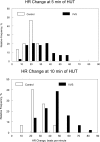Postural Heart Rate Changes in Young Patients With Vasovagal Syncope
- PMID: 28351846
- PMCID: PMC5369676
- DOI: 10.1542/peds.2016-3189
Postural Heart Rate Changes in Young Patients With Vasovagal Syncope
Abstract
Background and objectives: Recurrent postural vasovagal syncope (VVS) is caused by transient cerebral hypoperfusion from episodic hypotension and bradycardia; diagnosis is made by medical history. VVS contrasts with postural tachycardia syndrome (POTS), defined by chronic daily symptoms of orthostatic intolerance with excessive upright tachycardia without hypotension. POTS has recently been conflated with VVS when excessive tachycardia is succeeded by hypotension during tilt testing. We hypothesize that excessive tachycardia preceding hypotension and bradycardia is part of the vasovagal response during tilt testing of patients with VVS.
Methods: We prospectively performed head-up tilt (HUT) testing on patients with recurrent VVS (n = 47, 17.9 ± 1.1 y), who fainted at least 3 times within the last year, and control subjects (n = 15, 17.1 ± 1.0 y), from age and BMI-matched volunteers and measured blood pressure, heart rate (HR), cardiac output, total peripheral resistance, and end tidal carbon dioxide.
Results: Baseline parameters were the same in both groups. HR (supine versus 5 and 10 minutes HUT) significantly increased in control (65 ± 2.6 vs 83 ± 3.6 vs 85 ± 3.7, P < .001) and patients with VVS (69 ± 1.6 vs 103 ± 2.3 vs 109 ± 2.4, P < .001). HUT in controls maximally increased HR by 20.3 ± 2.9 beats per minute; the increase in patients with VVS of 39.8 ± 2.1 beats per minute was significantly greater (P < .001). An increase in HR of ≥40 beats per minute by 5 and 10 minutes or before faint with HUT, occurred in 26% and 44% of patients with VVS, respectively, but not in controls.
Conclusions: Orthostasis in VVS is accompanied by large increases in HR that should not be construed as POTS.
Copyright © 2017 by the American Academy of Pediatrics.
Conflict of interest statement
POTENTIAL CONFLICT OF INTEREST: The authors have indicated they have no potential conflicts of interest to disclose.
Figures

 for all 47 patients was 10 minutes, 40 seconds.
for all 47 patients was 10 minutes, 40 seconds.

Comment in
-
Differentiating Between Postural Tachycardia Syndrome and Vasovagal Syncope.Pediatrics. 2017 Apr;139(4):e20164161. doi: 10.1542/peds.2016-4161. Pediatrics. 2017. PMID: 28351847 No abstract available.
References
-
- Sheriff DD, Nådland IH, Toska K. Role of sympathetic responses on the hemodynamic consequences of rapid changes in posture in humans. J Appl Physiol (1985). 2010;108(3):523–532 - PubMed
-
- Brack KE, Coote JH, Ng GA. Vagus nerve stimulation inhibits the increase in Ca2+ transient and left ventricular force caused by sympathetic nerve stimulation but has no direct effects alone–epicardial Ca2+ fluorescence studies using fura-2 AM in the isolated innervated beating rabbit heart. Exp Physiol. 2010;95(1):80–92 - PubMed
-
- Raczak G, La Rovere MT, Mortara A, et al. . Arterial baroreflex modulation of heart rate in patients early after heart transplantation: lack of parasympathetic reinnervation. J Heart Lung Transplant. 1999;18(5):399–406 - PubMed
-
- Toda N, Ayajiki K, Okamura T. Cerebral blood flow regulation by nitric oxide: recent advances. Pharmacol Rev. 2009;61(1):62–97 - PubMed
MeSH terms
Grants and funding
LinkOut - more resources
Full Text Sources
Other Literature Sources

